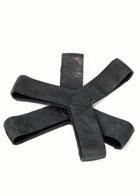Diverantz
Registered
Hey internet dive buddies, looking for expert advice!
I'm just a baby diver and have been since my drysuit misadventures started, though by now I'm nearly up to 100 dives and wearing out my newbie excuses. Here's my sad drysuit story.
I got drysuit certified in La Jolla in Feb 2022. It went okay until my rented mask swamped, and while I was trying to clear it I caught air and did an unplanned ascent...shallow, but still-
So I tried again, in Lake Allure, May 2023. This time, ruin in the first five minutes: I'd overweighted myself, lost a fin, and sank to the (luckily shallow) bottom. I did the first dive, wound up being dangerously cold (didn't wear the undergarments, thought they'd be too "bulky"), couldn't even do the second dive.
OK. Third try. Present day. Last week I'm in the pool, tucking and rolling, when I catch too much air in my feet, unplanned ascent, can't right myself, lose a fin. Classic me in a drysuit.
Am I taking this act to the quarry this weekend? You betcha. Need all your tips and tricks for survival.
Maybe I can partially blame the ill-fitting rental gear for these mishaps, but am I really going all in and buying a drysuit at this point?
Also, if somebody in the Washington DC area wants to train a floundering would-be drysuiter, as, like, your do-good springtime project I'm here for it-
I'm just a baby diver and have been since my drysuit misadventures started, though by now I'm nearly up to 100 dives and wearing out my newbie excuses. Here's my sad drysuit story.
I got drysuit certified in La Jolla in Feb 2022. It went okay until my rented mask swamped, and while I was trying to clear it I caught air and did an unplanned ascent...shallow, but still-
So I tried again, in Lake Allure, May 2023. This time, ruin in the first five minutes: I'd overweighted myself, lost a fin, and sank to the (luckily shallow) bottom. I did the first dive, wound up being dangerously cold (didn't wear the undergarments, thought they'd be too "bulky"), couldn't even do the second dive.
OK. Third try. Present day. Last week I'm in the pool, tucking and rolling, when I catch too much air in my feet, unplanned ascent, can't right myself, lose a fin. Classic me in a drysuit.
Am I taking this act to the quarry this weekend? You betcha. Need all your tips and tricks for survival.
Maybe I can partially blame the ill-fitting rental gear for these mishaps, but am I really going all in and buying a drysuit at this point?
Also, if somebody in the Washington DC area wants to train a floundering would-be drysuiter, as, like, your do-good springtime project I'm here for it-






